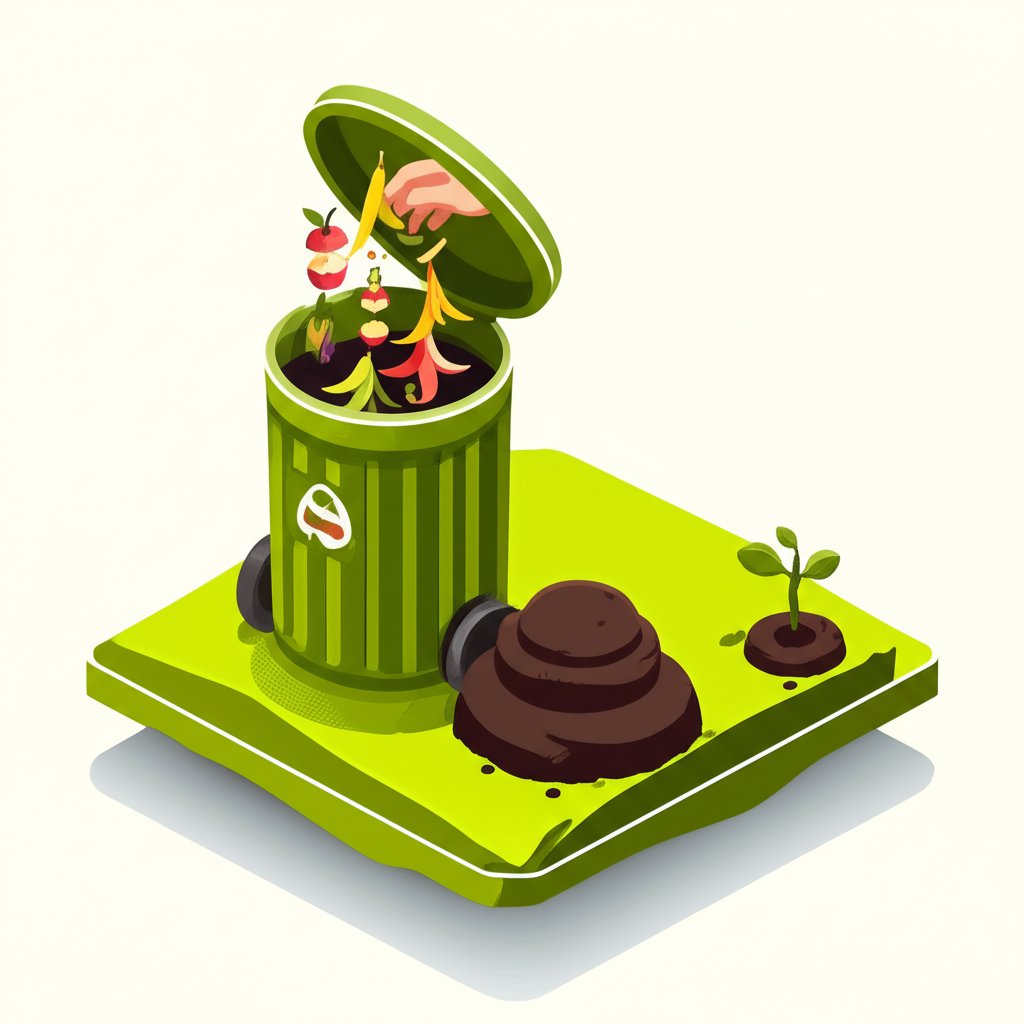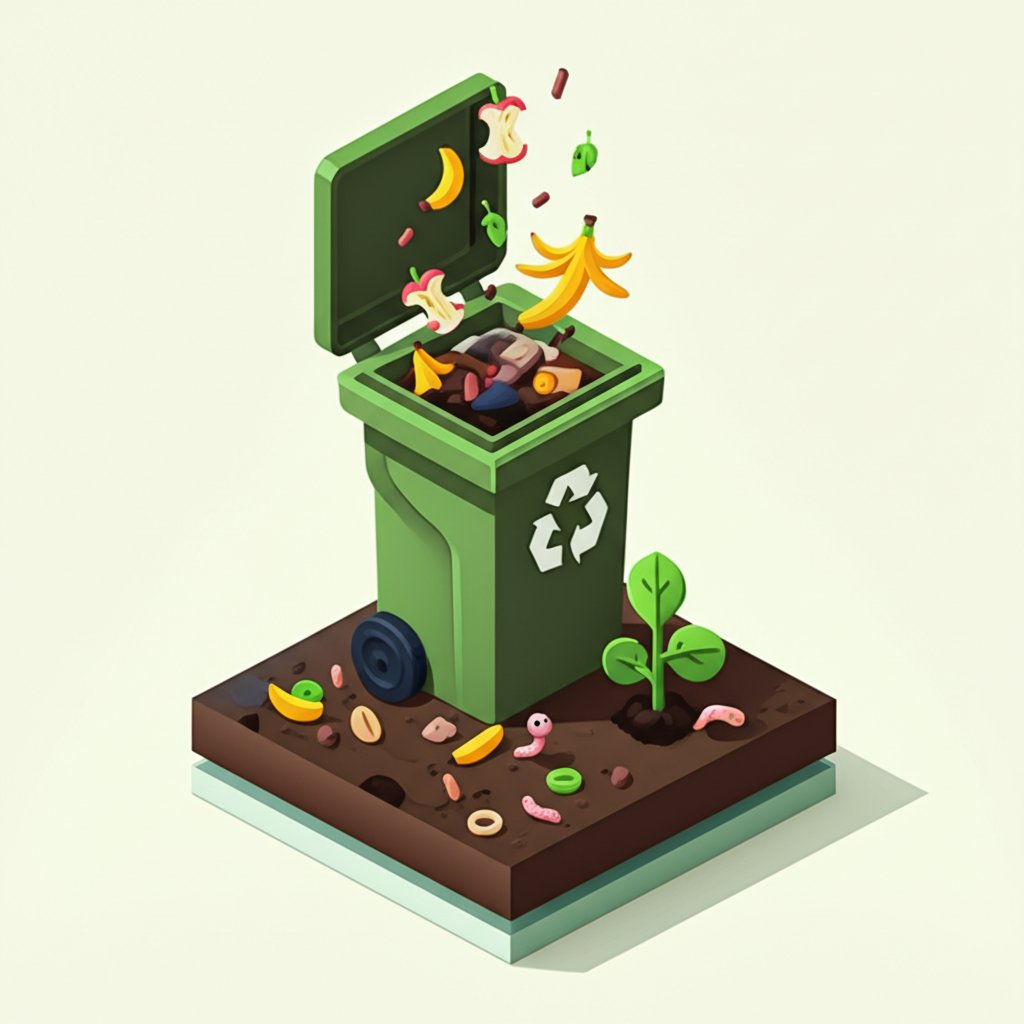Are you constantly looking for ways to reduce your environmental footprint and transform everyday waste into something valuable? The answer lies in composting food. Far more than just a trend, food composting represents a powerful shift towards a circular economy, turning kitchen scraps into nutrient-rich soil amendment. This comprehensive guide will unravel the essential composting food facts, equip you with practical techniques, and highlight why this practice is a vital sustainable solution for our planet. Join us on a journey to discover how mastering food waste composting can not only benefit your garden but also contribute significantly to global environmental health.
Understanding Composting Food: A Natural Cycle

At its core, composting food is a natural process where organic materials decompose under controlled conditions to form a dark, crumbly, earth-smelling substance known as compost. This isn’t just rotting; it’s a carefully managed breakdown facilitated by microorganisms, insects, and fungi, transforming matter into a valuable resource. It’s nature’s ultimate recycling program, mimicking the decomposition that occurs on forest floors.
The Science Behind Food Composting
The magic of food composting happens through a complex interplay of biology and chemistry. Microorganisms, primarily bacteria and fungi, act as decomposers. They feed on the organic waste, breaking down complex molecules into simpler forms. This biological activity generates heat, which is crucial for accelerating the process and killing off pathogens. A balanced mix of “greens” (nitrogen-rich, like food scraps) and “browns” (carbon-rich, like dry leaves) provides the ideal diet for these microscopic workers, alongside sufficient moisture and aeration. This synergistic process creates hummus – a stable, dark, nutrient-rich material that enriches soil.
Composting Food: A Historical Perspective
While modern composting methods might seem innovative, the practice of composting food and other organic matter dates back millennia. Civilizations as old as the Indus Valley and ancient Romans understood the value of returning organic matter to the soil to enhance fertility. Early records suggest farmers have been intentionally piling and turning organic wastes for at least 12,000 years. This ancient wisdom underscores its timeless efficacy and importance as a fundamental agricultural practice.
Why Composting Food is a Crucial Sustainable Solution

The impact of food waste composting extends far beyond individual gardens, addressing some of the most pressing environmental challenges of our time. It’s a cornerstone of waste reduction and a powerful tool in the fight against climate change.
Dramatically Reducing Landfill Waste and Methane Emissions
One of the most compelling composting food facts highlights the staggering amount of food waste that ends up in landfills. In the United States, a mere 4.1% of food waste is composted annually, equating to millions of tons of organic material rotting away. When organic matter decomposes in oxygen-deprived landfills, it produces methane, a potent greenhouse gas 25 times more effective at trapping heat than carbon dioxide. By diverting food scraps to food waste composting, we drastically reduce methane emissions, directly mitigating climate change. The EPA actively promotes food waste composting as a key strategy in its Sustainable Management of Food hierarchy, recognizing its critical environmental benefits.
Enriching Soil and Boosting Plant Health
Compost is often called “black gold” for a reason. Incorporating it into soil improves its structure, increases water retention, and provides a slow-release source of essential nutrients. This reduces the need for synthetic fertilizers, which can harm soil microorganisms and pollute waterways. For home gardeners, this means healthier, more resilient plants, often yielding better produce. For larger agricultural operations, this translates to more sustainable farming practices and improved long-term soil health – a truly sustainable solution.
Economic Advantages: Saving Money and Resources
Beyond environmental benefits, composting food offers tangible economic advantages. For individuals, businesses, and municipalities, diverting organic waste from landfills can significantly reduce costs associated with waste hauling and disposal fees. Instead of paying to dispose of waste, communities can invest in composting infrastructure, creating green jobs and producing a valuable product. Schools that implement food composting programs often see reduced cafeteria waste expenses and gain a powerful educational tool for students.
Effectively managing compost and other household waste is essential, so understanding the best practices for waste and recyclables storage can further contribute to a cleaner, more organized, and environmentally conscious home.
Fostering Community Engagement and Environmental Education
Composting can be a catalyst for community action. Neighborhood composting programs, school initiatives, and municipal drop-offs encourage citizens to actively participate in waste management. These programs often serve as educational hubs, teaching participants about waste reduction, soil science, and the broader principles of sustainability. By engaging students in hands-on food composting, we cultivate a generation of environmentally conscious citizens who understand the importance of closing the loop on waste.
Getting Started with Food Composting: Methods and Materials
Adopting composting food into your routine is simpler than you might think. There are various methods suitable for different living situations, from small apartments to large homes with gardens.
What You Can and Cannot Compost: Essential Composting Food Facts
Understanding what goes into your compost pile is crucial for success. A good rule of thumb is “If it grew, it goes!” but there are important exceptions.
Compost-Friendly “Green” Materials (Nitrogen-Rich):
- Fruit and vegetable scraps (peels, cores, bruised parts)
- Coffee grounds and filters
- Tea bags (ensure they are staple-free or plastic-free)
- Eggshells (crushed for faster decomposition)
- Fresh grass clippings (in moderation to avoid sliminess)
- Old flowers and houseplant trimmings
Compost-Friendly “Brown” Materials (Carbon-Rich):
- Dry leaves
- Shredded newspaper and cardboard (non-glossy, cut into small pieces)
- Sawdust and wood shavings (from untreated wood)
- Straw and hay
- Peanut shells
What to Avoid (and why):
- Meat, bones, fish, dairy products, and oily foods: These attract pests (rodents, flies), create foul odors, and can harbor harmful pathogens.
- Diseased plants: Could spread disease to your garden.
- Weeds with seeds: Seeds can survive the composting process and sprout in your garden.
- Pet waste (dog/cat): Contains pathogens that are unsafe for food gardens. (Note: Composting human waste, or “humanure,” is a specialized, high-temperature process requiring expert management and is not safe or practical for typical home compost piles due to pathogen concerns, though composting toilets can produce material for ornamental gardens in some regions).
- Heavily processed foods: Often contain preservatives or unhealthy ingredients.
- Coal ash or charcoal briquettes: Contain substances harmful to plants.
- Synthetic materials: Plastics, foil, chemically treated wood.
Home Composting Methods for Every Lifestyle
Whether you have a sprawling yard or a small balcony, there’s a food composting method for you.
1. Traditional Outdoor Compost Piles or Bins:
- Open Piles: Simple for those with space. Just pile greens and browns, turn occasionally. Less contained, may attract pests if not managed well.
- Compost Bins: Enclosed structures (plastic tumblers, wooden bins, wire cages) that offer more control and tidiness. Tumblers make turning easy. Bins help retain heat and moisture. Aim for a good green-to-brown ratio (ideally 1 part green to 2-3 parts brown by volume), keep it moist like a wrung-out sponge, and turn regularly for aeration.
2. Vermicomposting (Worm Composting):
- Ideal for small spaces like apartments or balconies. Red wiggler worms do the work, turning food scraps into nutrient-rich “worm castings.”
- Requires a specialized bin with multiple trays. Feed worms small amounts of fruit and vegetable scraps, coffee grounds, and shredded paper. Avoid citrus, onions, and meat/dairy.
- Produces excellent compost and compost tea.
3. Bokashi Composting:
- An anaerobic (oxygen-free) fermentation process. Food scraps are packed into an airtight container and layered with a special inoculant (usually bran with beneficial microbes).
- Can compost almost any food waste, including meat and dairy, without odors if sealed properly.
- The fermented “pre-compost” isn’t ready for plants directly but needs to be buried in the garden or added to a traditional compost pile for final breakdown.
4. Trench Composting:
- A simple, low-maintenance method where food scraps are buried directly in a garden trench or hole.
- Excellent for discreetly adding nutrients to specific areas of your garden, but less efficient for large volumes.
Municipal and Community Composting Programs
Many cities and towns are recognizing food waste composting as a critical sustainable solution.
Advanced Composting Food Facts and Best Practices
To truly master composting food, delve deeper into the nuances that optimize the process and yield superior results.
The Dynamics of a Healthy Compost Pile
A thriving compost pile is a living ecosystem. The decomposition process can generate significant heat, with internal temperatures reaching up to 75 degrees Celsius (167 degrees Fahrenheit) in just a few days. This heat is a sign of robust microbial activity and is crucial for breaking down materials quickly and sanitizing the compost by killing weed seeds and harmful pathogens. The ratio of carbon to nitrogen (C:N ratio) is key; an ideal range is 25-30 parts carbon to 1 part nitrogen. Maintaining adequate moisture (like a damp sponge) and aeration (turning the pile) ensures the microbes have the perfect environment to work efficiently.
Global Leaders in Food Waste Composting
While the US has room for improvement, composting food facts show remarkable progress globally. There has been a 65% increase in composting initiatives worldwide in the last five years alone. South Korea stands out as a global leader, composting more food waste than any other country. Their success is often attributed to mandatory food waste separation, incentivized collection, and advanced large-scale processing facilities, offering valuable lessons for other nations seeking a comprehensive sustainable solution.
Beyond Soil: Creative Uses and Fascinating Facts
Compost offers more than just garden enrichment. Did you know:
Overcoming Challenges in Food Waste Composting
Even the most dedicated composters encounter hurdles. Knowing how to address common issues ensures your food composting journey remains successful and rewarding.
Common Problems and Their Solutions
- Odor: A foul smell usually indicates too much “green” (nitrogen), too much moisture, or insufficient aeration.
- Solution: Add more “browns” (dry leaves, shredded paper), turn the pile more frequently, and ensure it’s not waterlogged.
- Pests (Rats, Flies, Ants): Attracted by exposed food scraps, especially meat, dairy, or oily foods.
- Solution: Never add prohibited items. Bury fresh food scraps deep within the pile. Use an enclosed compost bin. Ensure proper green-to-brown ratio to speed up decomposition.
- Slow Decomposition: Not enough moisture, aeration, or an imbalanced C:N ratio can slow things down.
- Solution: Moisten the pile if dry. Turn it more often. Adjust the C:N ratio by adding more greens or browns as needed. Chop food scraps into smaller pieces for faster breakdown.
- Pile Isn’t Heating Up: Often due to lack of mass, too much carbon, too little nitrogen, or insufficient moisture/aeration.
- Solution: Build a larger pile (minimum 3x3x3 feet for effective heat). Check C:N ratio. Ensure adequate moisture and turn regularly.
Tips for Success with Food Composting
- Chop it Up: Smaller pieces of food waste decompose faster.
- Balance is Key: Maintain a good mix of “greens” (nitrogen) and “browns” (carbon).
- Keep it Moist: The pile should be damp, not soggy or dry.
- Aerate Regularly: Turning the pile supplies oxygen to the microbes and prevents compaction.
- Location Matters: Place your outdoor compost pile in a shaded, well-draining area, away from structures.
- Be Patient: Composting takes time. Depending on the method and conditions, it can take anywhere from a few weeks to several months.
Conclusion: Unlock the Potential of Composting Food
Composting food is more than just a chore; it’s a powerful act of environmental stewardship, a practical sustainable solution, and a profound connection to the natural cycles of our planet. By transforming your kitchen scraps into rich, life-giving compost, you directly address critical issues like landfill overcrowding and greenhouse gas emissions, while simultaneously enriching your garden and fostering a healthier ecosystem.
The simple act of diverting food waste composting from the trash contributes to a circular economy, where “waste” is reimagined as a valuable resource. Embrace the myriad composting food facts and put them into practice. Whether you choose a backyard bin, a worm farm, or participate in a community program, every scrap diverted makes a difference. Start your food composting journey today and become a master of sustainable waste solutions, creating a flourishing future for generations to come.
FAQ: Your Top Questions About Composting Food Answered
Q1: What exactly is composting food?
A1: Composting food is the natural process of recycling organic matter, such as food scraps and yard waste, into a valuable soil amendment called compost. It uses microorganisms, insects, and fungi to break down materials under controlled conditions, transforming them into a nutrient-rich substance for gardening.
Q2: Why is food composting considered a sustainable solution?
A2: Food composting is a sustainable solution because it significantly reduces the amount of food waste sent to landfills, thereby decreasing methane emissions (a potent greenhouse gas). It also creates nutrient-rich compost that improves soil health, reduces the need for chemical fertilizers, conserves water, and fosters a circular economy.
Q3: What are some important composting food facts regarding waste statistics?
A3: In the United States, only about 4.1% of food waste is composted annually, amounting to millions of tons. Globally, there has been a 65% increase in composting initiatives in the last five years, with countries like South Korea leading the way in comprehensive food waste composting programs.
Q4: What types of food can I compost at home, and what should I avoid?
A4: You can compost fruit and vegetable scraps, coffee grounds, tea bags (staple-free), and eggshells. You should avoid composting meat, bones, fish, dairy products, oily foods, and pet waste, as these can attract pests, create odors, and harbor harmful pathogens unsafe for home compost.
Q5: How does food waste composting help slow climate change?
A5: When food waste goes to landfills, it decomposes anaerobically (without oxygen), producing methane gas. Methane is a greenhouse gas far more potent than carbon dioxide. By diverting food waste composting from landfills, we reduce methane emissions, directly contributing to the fight against climate change.
Q6: What are the main benefits of using compost in my garden?
A6: Compost enriches soil by adding essential nutrients, improves soil structure, increases water retention, and supports beneficial microbial life. This leads to healthier, more resilient plants, often reducing the need for synthetic fertilizers and pesticides.
Q7: Can I compost food waste if I live in an apartment?
A7: Yes! Methods like vermicomposting (using worms in a specialized bin) or Bokashi composting (anaerobic fermentation) are excellent for apartment dwellers. Many communities also offer municipal or communal food composting drop-off programs.
Q8: How long does it take for food to become compost?
A8: The time it takes for composting food varies depending on the method, materials, and management. Hot composting, with a good balance of greens/browns, moisture, and frequent turning, can produce usable compost in as little as 2-3 months. Slower methods might take 6-12 months.










